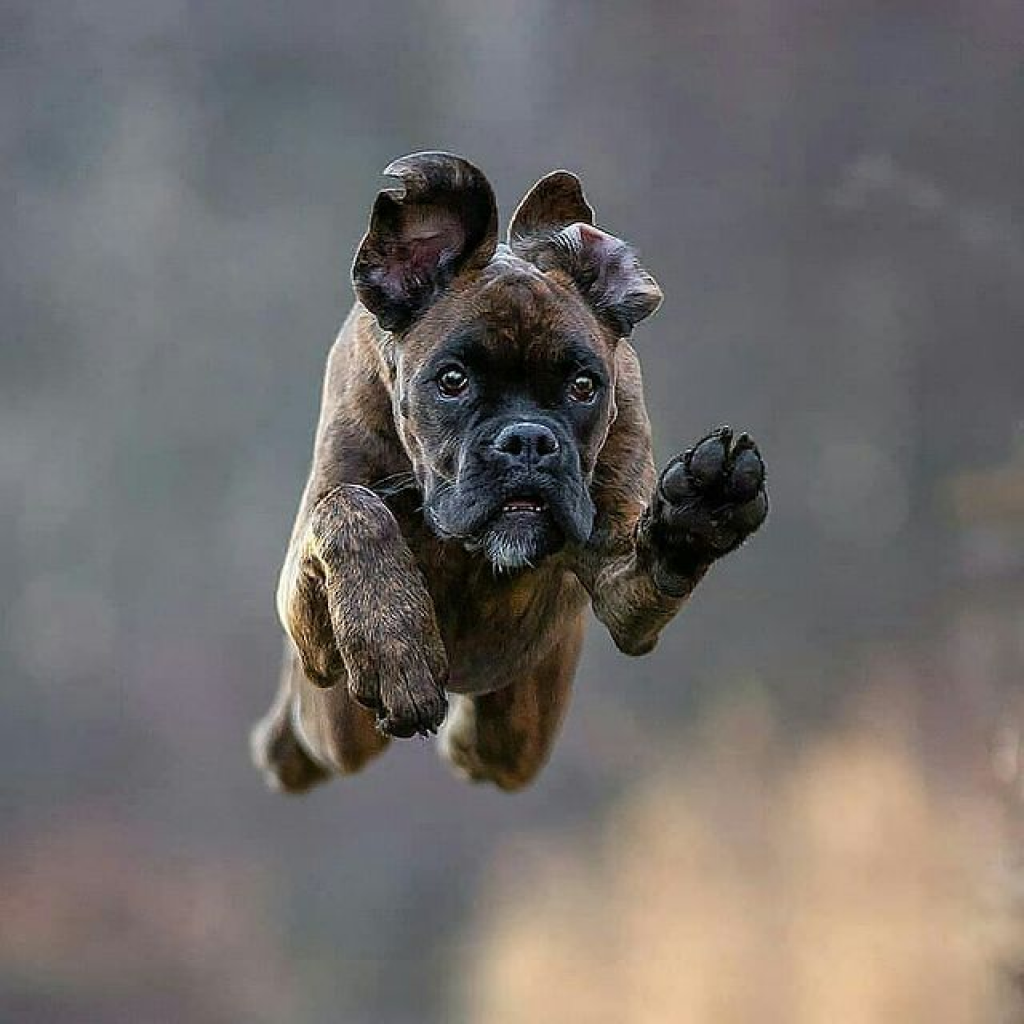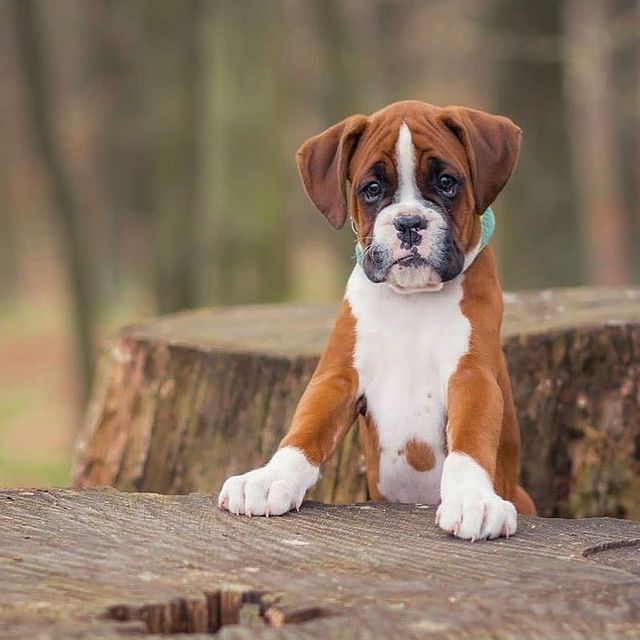
Understanding the Boxer Breed
Boxers are a distinguished breed originating in Germany, known for their robustness, agility, and spirited demeanor. Initially bred from the now-extinct Bullenbeisser and the Old English Bulldog in the late 19th century, Boxers were used for hunting large game. Their roles evolved, including tasks like cart pulling, cattle herding, and even serving in police and military roles in Germany. Boxers are medium to large dogs, characterized by their muscular build, short coat, and unique head structure with a broad, short skull and strong jaw.
This breed is not just known for its physical attributes but also its dynamic temperament. Boxers are playful energetic, and form strong bonds with their families. They are affectionate protective, and can be good with children, making them excellent family pets. Despite their protective instinct, they are generally friendly towards strangers when adequately socialized. However, potential owners should know the breed’s high energy levels and that the breed needs regular exercise and mental stimulation to prevent boredom and behavioral issues.
Critical Characteristics of Boxers:
- Origin: Germany, late 19th century.
- Physical Traits: Muscular build, short coat, broad and short skull.
- Standard Colors: Fawn or brindle with white markings.
- Size: 21 to 25 inches at the shoulder, 50 to 80 pounds.
- Temperament: Playful, energetic, affectionate, protective.
- Exercise Needs: High; requires regular physical and mental stimulation.
- Health Considerations: Prone to heart conditions, hip dysplasia, and certain cancers.
- Lifespan: Typically 10 to 12 years.
- Care Requirements: Balanced diet, regular exercise, minimal grooming, sensitivity to extreme temperatures.
Understanding these critical aspects of the Boxer breed is crucial for any potential owner or trainer. It sets the stage for discussing their training needs and how to effectively nurture and manage this spirited and loyal breed.
Critical Stages in Boxer Puppy Growth
Like all breeds, boxer puppies go through several critical developmental stages as they grow. Understanding these stages is crucial for implementing appropriate training and care strategies that cater to their physical and psychological needs.
The Early Weeks (8-16 Weeks)
This period is crucial for a Boxer puppy’s social and physical development. At this stage, puppies are highly receptive to new experiences, which makes it an ideal time to start basic training and socialization. They learn about their environment, interact with other dogs and humans, and start understanding basic commands. This is also when vaccinations are typically started, ensuring their health as they explore more of the world.
Development by 6 Months
By six months, a Boxer puppy will have grown significantly and exhibit more of its personality. This is a period of rapid physical growth and mental development. Training should continue to be consistent, focusing on reinforcing the basic commands learned earlier and introducing more complex training exercises. It’s also crucial to establish and maintain boundaries, as Boxers are known for being strong-willed.
Growth Milestones by One Year
Reaching one year, Boxer puppies are considered adolescents. Although they may look physically mature, they still require guidance and training as their personalities and behaviors develop. At this stage, it’s essential to continue with structured training, socialization, and exercise to prevent any behavioral issues from becoming ingrained. Consistency in training and routine is critical to ensuring a well-behaved adult Boxer.
Understanding these growth stages helps in creating a targeted training program that aligns with the physical and mental development of Boxer puppies. Each stage requires a different focus, adapting to the changing needs of the growing Boxer.
Starting Boxer Puppy Training

Training a Boxer puppy requires patience, consistency, and an understanding of the breed’s characteristics. Training early and adapting to the puppy’s developmental stages is crucial in raising a well-behaved and balanced dog.
When to Begin Training
The best time to begin training a Boxer puppy is around 8 to 10 weeks old. They can learn basic commands at this age and are highly receptive to new experiences. Early training lays the foundation for future learning and helps establish a bond between the owner and the puppy. It’s essential to keep training sessions short, fun, and positive, as puppies have short attention spans.
Critical Considerations for Training Boxers
Boxers are intelligent but stubborn, so they must be firm and consistent in training. They respond well to positive reinforcement techniques such as praise, treats, and play. Harsh methods should be avoided as they can lead to trust issues and exacerbate stubborn behavior. Socialization is also a crucial aspect of training Boxers. Exposing them to various people, animals, environments, and experiences helps develop a well-rounded and friendly dog.
Training should cover basic obedience commands like sit, stay, come, heel, and down. Working on leash training is also essential, as Boxers are strong dogs and can be exuberant on walks. Crate training benefits housebreaking and provides the puppy with a safe space. Consistency in routine and commands is key; different family members should use the same commands to avoid confusing the puppy.
Starting Boxer puppy training with these considerations in mind sets the stage for a rewarding journey of growth and learning for both the puppy and the owner.
Boxer Breed Characteristics and Training Implications
Boxers are a unique breed with specific characteristics that directly influence their training approach. Understanding these traits can help develop an effective training program tailored to their needs.
- Intelligence and Energy: Boxers are brilliant and energetic. They require mental stimulation to keep them engaged and prevent boredom, which can lead to destructive behavior. Training should include activities challenging their minds, like puzzle toys, obedience training, and agility exercises.
- Strong-Will and Independence: This breed can exhibit a strong-willed nature, making consistent, patient training essential. They respond best to positive reinforcement and require an owner who can assert gentle yet firm leadership.
- Sociability and Playfulness: Boxers are known for their friendly and playful disposition. Incorporating play into training sessions can enhance learning and make training more enjoyable for them. Socialization should be a part of their routine to maintain their well-rounded temperament.
- Protective Instincts: Boxers are naturally protective, which makes early socialization and training essential to ensure they do not develop overprotective behaviors. Training should focus on helping them understand when to be protective and when to be relaxed.
- Physical Strength and Stamina: Due to their physical strength and high stamina, Boxers require regular exercise. This not only helps in keeping them physically fit but also aids in mitigating any hyperactive tendencies.
- Sensitivity to Extremes: Boxers are sensitive to extreme temperatures. Training sessions should be adjusted according to weather conditions, ensuring they are not exposed to excessive heat or cold.
These breed-specific characteristics should be considered when devising a training plan for Boxers. The training methods must align with their temperament and physical capabilities to ensure effective learning and a happy, well-adjusted dog.
Structured Training Program for Boxers
Given their intelligence, energy, and specific breed characteristics, a structured training program is vital for Boxers. A week-by-week guide helps in systematically introducing new commands and reinforcing learned behaviors.
Week 1: Basic Commands and Socialization
- Focus: Introduce basic commands like ‘sit,’ ‘stay,’ ‘come,’ and ‘down.’ Start with short, positive training sessions.
- Socialization: Begin exposing your Boxer puppy to different sights, sounds, and experiences in a controlled manner.
- Exercise: Short walks and play sessions to help expend energy.
Week 2: Advancing Training Techniques
- Focus: Build on basic commands, introducing more complex commands or extending the duration of commands like ‘stay.’
- Consistency: Ensure consistency in commands and routines.
- Socialization: Continue with socialization, gradually increasing the types of experiences.
Week 3: Behavioral Training
- Focus: Address common puppy behaviors such as biting, barking, and jumping. Use positive reinforcement to encourage desired behaviors.
- Boundaries: Start teaching boundaries within the home.
- Exercise: Introduce structured play and exercise routines.
Week 4: Obedience and Discipline
- Focus: Reinforce obedience training. Introduce leash training and continue with crate training.
- Discipline: Start instilling discipline in daily routines, such as feeding and walking times.
- Socialization: Keep socializing in different environments.
Week 5: Reinforcing Learned Skills
- Focus: Review all previously learned commands and behaviors, reinforcing them through repetition and rewards.
- Challenges: Introduce new challenges in training to keep it engaging.
- Exercise: Maintain regular exercise and play routines.
Week 6: Advanced Socialization
- Focus: Enhance socialization with other dogs and people in various settings.
- Training: Introduce more complex training scenarios, like walking through crowded areas.
- Consistency: Continue consistent daily training routines.
Week 7: Preparing for Advanced Training
- Focus: Prepare for advanced training such as agility or more complex obedience skills.
- Review: Assess progress and identify any areas needing more attention.
- Exercise: Keep up with physical and mental stimulation.
Week 8: Finalizing Puppy Training
- Focus: Consolidate all training lessons from the previous weeks.
- Assessment: Evaluate the puppy’s response to training and make adjustments as necessary.
- Future Planning: Plan for ongoing training and development.
This structured approach helps steadily build a Boxer puppy’s skills and confidence. Being adaptable and patient is essential, as each dog learns at its own pace. Consistent reinforcement and positive experiences are essential to successful training.
Continuing Your Boxer’s Training Journey

As your Boxer puppy grows and masters the basics, the training journey evolves. Continuing education and reinforcement are vital to ensure your Boxer develops into a well-behaved and balanced adult dog.
After eight weeks of structured training, the focus should shift towards reinforcing and building upon the skills learned. This stage is about repeating what has been taught and gradually introducing more complex commands and scenarios. Keeping your Boxer mentally and physically challenging is essential to prevent boredom and maintain engagement in the training process.
It’s also important to start integrating training into everyday life situations during this phase. For example, practicing obedience commands in different settings, such as parks or busy streets, helps your Boxer learn to respond reliably, regardless of distractions. This is also an excellent time to start off-leash training in safe, enclosed areas, enhancing recall skills and giving your dog more freedom while ensuring they remain under control.
Consistency remains critical at this stage. Boxers are intelligent and can quickly pick up on inconsistencies in commands or routines, which might lead to confusion or selective obedience. All family members must be on the same page regarding commands and expectations.
Another aspect to consider is the continuation of socialization. As Boxers grow, their protective instincts may become more pronounced. Continued exposure to different people, animals, and environments helps ensure that these protective instincts don’t turn into aggression or overprotectiveness.
Additionally, as your Boxer matures, physical exercise needs become more pronounced. Boxers are high-energy, and adequate physical activity is crucial for their physical and mental well-being. Activities like running, hiking, or participating in dog sports can provide excellent outlets for their energy.
Remember, training is a lifelong journey for any dog, especially for a breed as dynamic and intelligent as the Boxer. Continued learning, love, and patience will ensure that your Boxer remains a well-adjusted and integral part of your family.
Effective Training Methods for Boxers
When training Boxers, specific methods have proven more effective, aligning well with their personality and learning style. Understanding and applying these methods can significantly enhance the dog’s and the owner’s training experience.
Positive Reinforcement Techniques
Positive reinforcement is one of the most successful approaches for training Boxers. This method involves rewarding desirable behaviors and encouraging the dog to repeat them. Rewards can be treats, praise, or playtime – anything the dog finds motivating. The key is to reward immediately after the desired behavior is performed to create a clear association between the behavior and the reward.
Clicker Training and Long Line Usage
Another effective method is clicker training, a form of positive reinforcement. A clicker is a small hand-held device that makes a distinct ‘click’ sound when pressed. The click sound marks the exact moment the dog performs the desired behavior, followed immediately by a reward. Over time, the dog learns to associate the click with positive outcomes, making it an effective tool for shaping and reinforcing new behaviors.
Consistency in House Training
Practical house training of a Boxer puppy hinges on establishing a consistent routine, particularly for feeding and toilet breaks. Choose a specific outdoor spot for toileting and consistently take your puppy there, using rewards and praise to reinforce good behavior. Handle indoor accidents calmly, guiding the puppy to the designated outdoor spot and thoroughly cleaning any indoor areas to prevent re-marking. Crate training can also be beneficial, providing a safe space and helping to prevent accidents. Regular supervision and adapting to the puppy’s cues are essential, with patience and positive reinforcement crucial throughout the training process.
Physical and Mental Stimulation for Boxers
Boxer dogs are known for their high energy levels and intelligence, necessitating ample physical and mental stimulation to keep them healthy and content. Adequate exercise and mental engagement prevent boredom and related behavioral issues.
Physically, Boxers need daily exercise to maintain their muscular build and overall health. This can include brisk walks, runs, playtime in a fenced yard, or agility training. Activities like fetch, tug-of-war, and interactive play sessions provide physical exercise and strengthen the bond between the dog and its owner. For mental stimulation, puzzle toys, scent games, and training sessions that challenge their intellect are excellent choices. These activities keep their minds active and can significantly reduce tendencies toward destructive behavior.
Incorporating training exercises into their daily routine also provides mental stimulation. Learning new commands or practicing existing ones in varied environments helps keep their mind engaged. Social interactions with other dogs and people also benefit their mental well-being, helping them develop into well-rounded and sociable pets.
Balancing physical and mental activities is critical to a happy and healthy Boxer. Regular, varied, engaging exercise routines will ensure your Boxer remains physically fit, mentally sharp, and emotionally satisfied.
Providing Proper Nutrition and Care
Proper nutrition is fundamental for a Boxer’s health and well-being. A balanced diet tailored to their age, size, and activity level is crucial. High-quality dog food, rich in protein, is recommended to support their muscular build and energy needs. It’s essential to avoid overfeeding to prevent obesity, a common issue in the breed. Regular vet check-ups, staying up-to-date with vaccinations, and routine worming are essential for their overall health. Additionally, due to their short coat, Boxers require minimal grooming, but regular checks for skin issues or allergies are advisable. Providing a loving, caring environment is equally important for their emotional well-being.
Addressing Boxer-Specific Behavioral Issues

Boxers can exhibit specific behavioral issues with their unique personality and energy levels. Recognizing and addressing these effectively is key to a harmonious relationship with your pet.
- Jumping Up: Boxers are known for their enthusiasm, which can lead to jumping on people. Consistent training to sit as a greeting and rewarding calm behavior can mitigate this.
- Chewing: Boxers might take to inappropriate chewing as a breed with strong jaws. Providing chew toys and discouraging chewing on non-toy items is essential.
- Separation Anxiety: Boxers can be prone to separation anxiety due to their strong attachment to their owners. Gradual desensitization to being alone and engaging in toys and activities can help.
- Stubbornness: This trait can be a challenge during training. Patience, consistency, and positive reinforcement are vital in managing this behavior.
- High Prey Drive: Boxers may have a strong chase instinct. Training them to respond to commands even in the presence of distractions is crucial.
Understanding and appropriately responding to these behaviors will ensure a well-adjusted and happy Boxer.
Advanced Training Tips for Boxers
Advanced training offers a range of benefits for Boxer owners looking to take their dog’s training to the next level. These tips can help deepen the bond between owner and pet while providing mental and physical challenges crucial for this intelligent and energetic breed.
- Obedience at Distance: Train your Boxer to respond to commands even when you’re not close by. This enhances their focus and responsiveness.
- Agility Training: Agility courses are excellent for physical exercise and mental stimulation. They help improve coordination, speed, and obedience.
- Advanced Heel: Moving beyond the basic heel command, train your Boxer to heel through crowded or distracting environments.
- Impulse Control: Work on training your Boxer to resist immediate temptations, like waiting patiently before eating or calmly greeting guests.
- Trick Training: Teaching complex tricks can be fun and mentally stimulating for your Boxer. It also strengthens communication between you and your dog.
These advanced training exercises keep your Boxer engaged and well-behaved and ensure their continued development and enrichment.
Comprehensive Conclusion on Boxer Training

In summary, training a Boxer dog is a rewarding journey that requires understanding, patience, and consistency. Boxers are a unique breed with specific needs and characteristics; their training should be adapted to them. The key takeaways from this comprehensive guide on Boxer training include:
- Understanding the Breed: Recognizing the specific traits of Boxers, such as their intelligence, energy, and playfulness, is crucial for practical training.
- Early and Consistent Training: Starting training early and maintaining consistency throughout the dog’s life is essential for their development.
- Positive Reinforcement: Boxers respond best to positive reinforcement techniques. Rewards, praise, and play encourage good behavior.
- Physical and Mental Stimulation: Regular exercise and mental challenges are necessary to keep a Boxer healthy and prevent behavioral issues.
- Routine and Structure: A structured routine helps in-house training and overall obedience.
- Socialization: Exposing Boxers to various environments and situations is crucial for a well-rounded temperament.
- Advanced Training: Engaging Boxers in advanced training and activities like agility can enhance their skills and provide necessary stimulation.
Ultimately, the goal is to raise a well-behaved, happy, and healthy Boxer. With the right approach and commitment, Boxer training can be a deeply fulfilling experience, strengthening the bond between you and your pet. Remember, every Boxer is an individual, and patience and adaptability are vital in meeting their specific needs and ensuring a successful training outcome.
